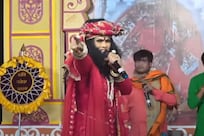The most astonishing feature of this Promethean work of reporting by the American journalist Katherine Boo is the sound of poor Indian voices that comes through every page. Their thoughts about their mothers and fathers, homes, neighbours, work, children and dreams are not often heard in a country where the poor are seen everywhere but are usually silent.
Indians tend to be scathing about anything on India written by a westerner - or even by an Indian based abroad. It's inevitably savaged as trite and superficial. But an avalanche of praise has descended on Boo's book about a Mumbai slum, Behind the Beautiful Forevers.
A Pulitzer Prize-winner and New Yorker staff writer known for her stories on urban poverty in America, Boo has produced a richly detailed, perceptive, superbly crafted and beautifully written book on the inhabitants of Annawadi, an ugly, stinking slum adjacent to the international airport in Mumbai. It is also close to five luxury hotels. In the first few weeks, Boo is treated as a circus freak by the slum-dwellers who, assuming she has lost her way to a nearby hotel, shout "Hyatt!" or "Intercontinental!" When she is still around, months later, recording conversations, conduct and incidents, she finally becomes a part not of the furniture (there is no furniture in these hovels) but of the landscape: the piles of rubbish, the excrement-caked pigs and goats, the alcoholics and the sewage lake.
It was Boo's husband, the well-known politics professor Sunil Khilnani, who suggested some time in 2007 that she could try to write about urban poverty in fast-changing India with more depth and understanding than some other western writers had been able to muster.
Boo hesitated. Her health was frail. Since her late teens, she has suffered from rheumatoid arthritis and several immunological disorders. She walks a little slowly and her slight frame seems stiff. Did it make sense for her, with a weak immune system, to go and spend time in a slum where tuberculosis is rampant?
But, one night at her home, she tripped over a dictionary, puncturing her lung and breaking three ribs. The New York Times quotes her as saying that this settled matters for her. "I thought, 'if I don't work, I'm risking my mental health'," she said.
So from 2007 to 2011, Boo spent long hours in Annawadi understanding the lives of the inhabitants, focusing primarily on two Muslim families. Known for her "immersion journalism", she taped hundreds of hours of audio and video tapes which she used to watch later in an attempt to fathom, from the gestures, facial expressions and inflections, what forces directed the slum dwellers' choices.
In the US, too, Boo used to follow her subjects around for weeks and months on end, sometimes interviewing but often just watching, taping and listening. ("Silence," she once said in a lecture, "is the most underused reporting tool we have".) Alongside the microscopic detail of individuals, her larger aim was to portray how and why some Indians have been left out of India's new prosperity and how others have managed to get ahead.
What she's produced is a tour de force, the sort of book that non-fiction books on India will henceforth be judged against. The Indian historian and columnist Ramachandra Guha called it the "best work of non-fiction that I have read in the past 25 years". Joseph Lelyveld, a former executive editor of The New York Times who has written extensively about India, compared the book to George Orwell's account of poverty in England, The Road to Wigan Pier.
The stories are so powerful and the characters so beautifully drawn that Behind the Beautiful Forevers reads like a novel about Annawadi's 3,000 residents. There is Abdul, a quiet, timid teenager who sorts out piles of rubbish to be given to recycling plants and whose operating principle is "avoid trouble" Asha, the tough Hindu woman married to an alcoholic who uses her political connections to climb out of poverty while also educating her daughter, the only person in Annawadi to attend college; and Fatima, a one-legged woman known for her sexual needs. When Abdul is falsely implicated in the death of one of the residents, he ends up in prison, facing the fight of his life.
Some of the characters are as eloquent as Boo. Abdul's father, Karam Husain, referring to the high aspirations everyone in Annawadi harbours, says: "Everyone in Annawadi talks like this: 'Oh, I will make my child a doctor, a lawyer, and he will make us rich'. It's vanity, nothing more. Your little boat goes west and you congratulate yourself, 'what a navigator I am!' And then the wind blows you east."
This arbitrary nature of lives of the poor is also nicely captured by Boo when she describes Abdul: "It seemed to him that in Annawadi, fortune was derived not just from what people did, or how well they did it, but from the accidents and catastrophes they dodged. A decent life was the train that hadn't hit you, the slumlord you hadn't offended, the malaria you hadn't caught."
As well as hope, there is despair and pathos in the slum. A young woman swallows rat poison, described as "one decision about her life she got to make". Hunger, disease, fear of the police and the constant anxiety that the slum will be razed create an overwhelming sense of powerlessness. Given Boo's unrelenting honesty, the slumdwellers themselves do not emerge as saints. They are not blameless victims. Yes, they are more sinned against than sinning, of course, but they also harm one another. Woe betide anyone who tries to "improve" himself by adding a shelf to the "kitchen" or by erecting a wall made of reject bricks rather than the standard scraps of aluminium. It makes the neighbours burn with envy.
If you are wondering about the title, it comes from a slogan on a wall that hides the slum from the city beyond.
"The ads were for Italianate floor tiles, and the corporate slogan ran the wall's length: Beautiful Forever Beautiful Forever Beautiful Forever," writes Boo.
Behind the Beautiful Forevers: Life, Death and Hope in a Mumbai Undercity by Katherine Boo, Random House, is out now






